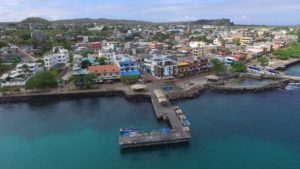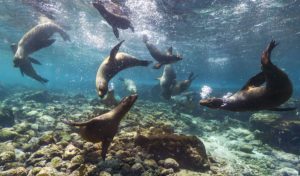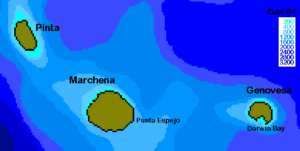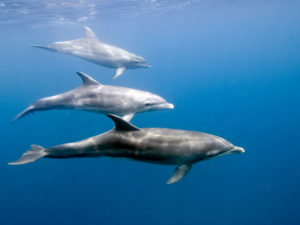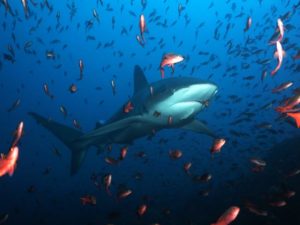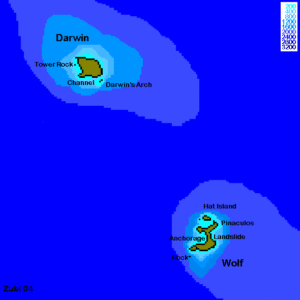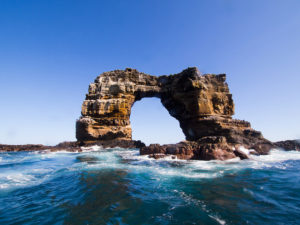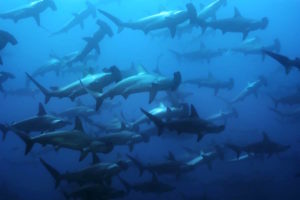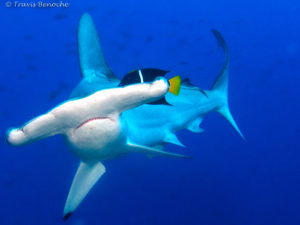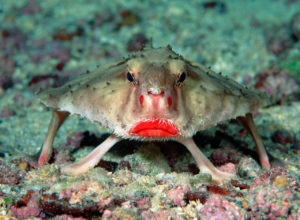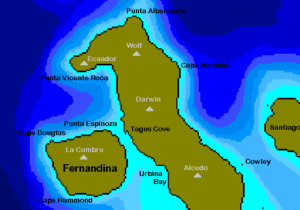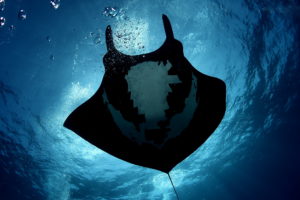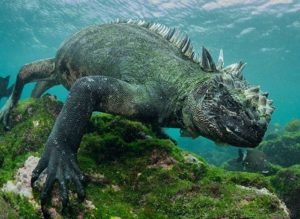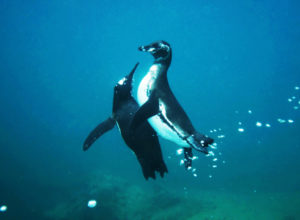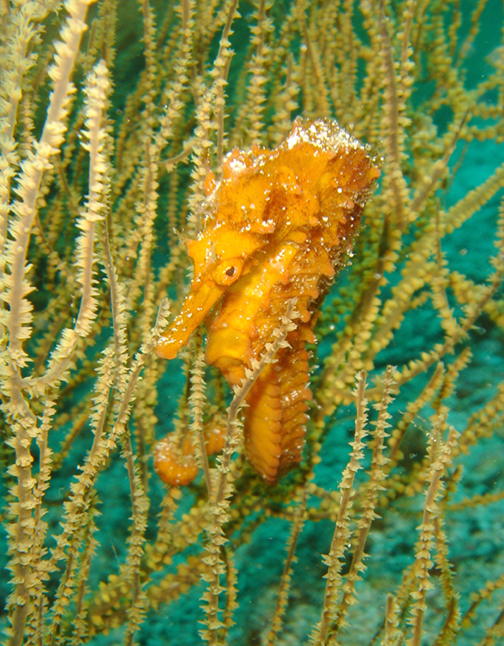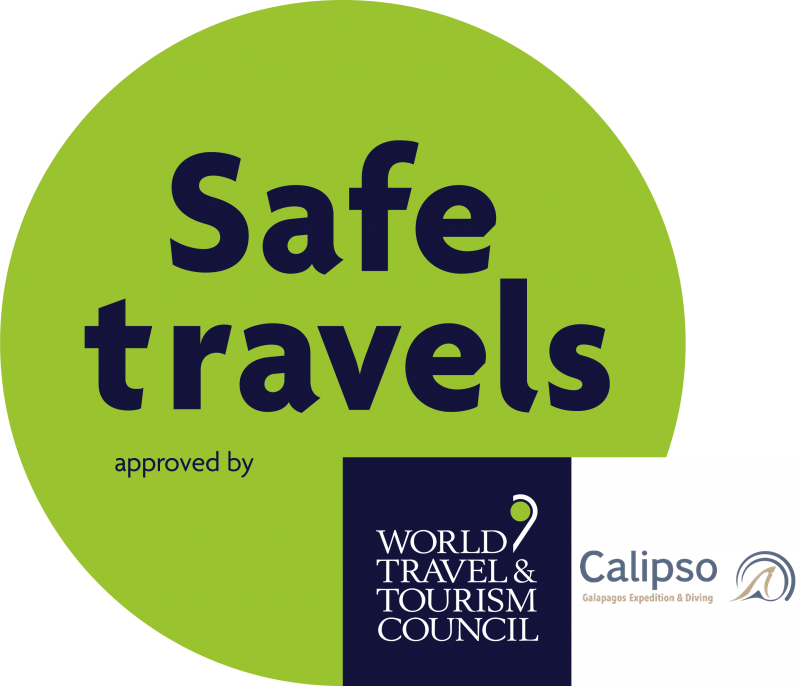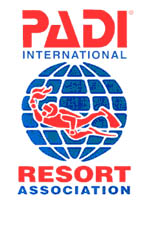Calipso Galapagos Dive Itinerary
Galapagos Liveaboard diving may ruin everywhere else for you.
Yes we have the high voltage diving at Darwin and Wolf Islands on our itinery. Hammerheads, Galapagos sharks, Silky sharks and Whale sharks in season. Darwin and Wolf put Galapagos on the map for divers.
Divers can begin to take ‘another school of hammerheads’ for granted (true), so like most Galapagos liveaboards, we also dive the western sites. Punta Vicente Roca is a Mola Mola cleaning station, is rich in species and perhaps has the most coral in all Galapagos. Cabo (Spanish for Cape) Marshall is a dependable site for giant Mantas. At Cabo Douglas, you dive with Marine Iguanas and Penguins while they feed. Cousins, our final dive, is in the Central Islands.
All Galapagos liveaboard itineraries are a minimum of 7 nights due to the distance of the remote sites we dive.
- Thu: Arrival
- Fri: Punta Carrion and Seymour
- Sat: Wolf
- Sun: Darwin
- Mon: Darwin-Wolf
- Tue: Isabela-Fernandina
- Wed: Cousins-Santa Cruz
- Thu: Departure
Diving begins early to get in all 4 dives in a 12 hour day. 4 dives and a night dive (optional) where you can see garden eels and the red-lipped batfish on a sandy bottom.
Itinerary FAQ
Do I need a Visa to enter Ecuador?
No visa is necessary from most countries, only the following: Afghanistan, Bangladesh, Cuba, Eritrea, Ethiopia, Kenya, Nepal, Nigeria, North Korea, Pakistan, Senegal and Somalia. This is always subject to change, so best to check the Ecuador Embassy website in your home country. You are allowed to stay up to 90 days in any 12 month period.
Your passport must have 6 months prior to expiration at the time you enter Ecuador. You must have a round trip (return) or onward ticket. You must have proof of health insurance coverage for the time of your stay in Ecuador. See more about this in the insurance FAQ.
Are there any travel advisories?
As travel advisories are always subject to change, please refer to any travel advisories issued by your own country’s authorities. Below are a few links:
US State Department
UK Foreign & Commonwealth Office
Australian Government Department of Foreign Affairs and Trade
Foreign Affairs and International Trade Canada
German Foreign Office
Please note that we can't list every country in the world, so if you don't see your home country listed here, please google the name of your country's embassy in Ecuador or your foreign travel office for additional information.
Do I need any vaccinations to enter Ecuador?
To fly into a mainland airport and visit Galapagos, no vaccinations are necessary. A Yellow Fever Vaccination is usually advised if you plan to visit the Amazon.
If you plan to arrive into Ecuador from a country that has Yellow Fever risk, you will need an International Certificate of Vaccination for Yellow Fever to be allowed entry into Ecuador.
If you plan to travel to a number of Central or South American countries after Ecuador, you may need an International Certificate of Vaccination for Yellow Fever to gain entry to those countries after Ecuador, regardless of whether or not you visited any areas deemed a risk. It is your responsibility to determine which countries the Certificate is necessary to have for entry as only you know your itinerary in advance.
For more in-depth information, please visit the Centers for Disease Control website. We recommend you visit a health care provider who specializes in Travel Medicine prior to your travels if you have any concerns.
Health Risks: While Galapagos, Quito and Guayaquil tend to be relatively disease free, dengue can be a risk on land. There is no vaccination against dengue, however, wearing long sleeves and using a DEET based repellent are good preventative measures.
Onboard Calipso, you will have no health risks from food or water. Bring your own water bottles to use while in Galapagos. Onboard and at all hotels, you can refill your bottle with purified water as often as you wish. At hotels on land, we recommend you brush your teeth with purified water and avoid questionable street food.
Do you have any packing tips?
First, please DO NOT over-pack. We highly recommend soft sided luggage rather than hard cases. It’s much easier to handle and store. You need almost nothing while onboard. If you are packing more than a medium-sized duffle bag (in addition to your dive gear), you have probably over-packed.
You should pack necessities in a carry on bag so you can manage if your luggage gets lost. (See 'Should I arrive early?'). Suggestions include a bathing suit, a change of clothes, a brush or comb and must have dive or camera gear.
Dive Gear: We recommend 7mm wetsuits and softsided booties. A hood or beanie is recommended, especially for the colder sites out west and Cousins Rock. A small dry bag is always good to have for panga rides or for storage on the dive deck. A small mesh bag can also be handy for storing things at your dive station.
Clothing: Jan through April is warm. Shorts and lightweight clothing will be fine. You might pack a light jacket or long sleeve t-shirt for evenings. Some may wish they had a hoodie after dives. From June - Nov, it can be surprisingly cool. Bring a fleece jacket or sweatshirt to use after dives. Like many other places, think layers. Do bring a hat that will protect you against the sun. A bandana is always good for neck protection. Even if the temperature is cool, it's still on the equator.
Misc: Reef safe sunscreen, biodegradable toiletries, rechargeable batteries, a water bottle and any prescription medications you may need. Many over the counter medications sold elsewhere are not available in Ecuador. Bonine (meclizine hydrochloride) is the one medication people who suffer from seasickness say helps the most. It is not sold in Ecuador. Dive skins are great to prevent wetsuit rash and as a sunblock when you are out of the water.
Documentation: Bring your Certification Card and your Nitrox Certification card. Bring your log book if you have one. Bring your completed Diver Booking Form and Waiver. Please download the sharkcount.org app before you arrive. Set up an account and then use the app while in Galapagos to help scientists protect our sharks. The app can be used without an internet connection and will automatically send your information to scientists once you have a connection again.
Do I need insurance?
Dive insurance is mandatory. We recommend Divers Alert Network for the US or Europe. If you live in another country, please check with your provider to make sure your policy has both recompression chamber and evacuation coverage.
Though the government has delayed enforcing the policy, it will become mandatory to have health insurance for the time you are in Ecuador. If your existing coverage does not provide international coverage, often a simple travel policy purchased when you buy your international flights will provide health coverage sufficient for the requirement.
Though travel insurance is not required, it is recommended in the event you have to cancel your departure due to illness, loss of employment or in the event you miss your connecting flight which causes you to miss your departure. Please read the fine print. What you assume is covered may not be.
Should I arrive early?
While the vast majority of divers arrive the evening before their flight to Galapagos and have no problem at all, there are those who arrive only to learn their luggage was not onboard their international flight. For those unfortunate few, it can create a big problem. It is logistically to collect your luggage once Calipso has sailed. If your bags don't come with you to Galapagos, you won't get them until you disembark a week later.
So, it is always safer to arrive early if for no other reason than to make certain your luggage arrives, too. Most arriving international guests appreciate the opportunity to rest and relax prior to diving. We can arrange hotels and day tours in Quito or Guayaquil.
If you are planning to add an extension in the Amazon to your holiday, we recommend visiting the Amazon before Galapagos. You might be disappointed in the Amazon after the fearlessness of the wildlife in Galapagos.
Where do I fly into?
Ecuador has 2 international airports: Quito (airport code UIO) and Guayaquil (airport code GYE). Most international flights arrive in the evening, so an overnight hotel is in order upon arrival. Quito is the newer airport, located approximately 70 minutes outside the city. All flights to Galapagos from Quito route through Guayaquil. You do not deplane and the wait is typically only 20 minutes or so. Quito is at an altitude of 2850 m / 9350 ft, so if you suffer from altitude sickness, you may want to consider only airlines that fly into Guayaquil, which is at sea level.
You fly from mainland Ecuador into San Cristobal airport in Galapagos (airport code SCY) on the morning of your departure.
Our official flights to Galapagos are on Avianca Airlines:
Thursday Arrival: Flight AV 1630 departs UIO at 10:15 AM. Arrives GYE at 11:10 AM. Departs GYE at 11:50 AM. Arrives SCY at 12:40 PM.
Thursday Departure: Flight AV 1631 departs SCY at 1:20 PM. Arrives GYE at 4:10 PM. Departs GYE at 4:50 PM. Arrives UIO at 5:45 PM.
Below are instructions for the procedure to check in for Galapagos flights. Please note that if you purchase your flights with us, we will meet you at the airport, handle this process for you and check you in as part of our group, thus avoiding the need to read all the instructions below. It's a wonderful convenience enabling you to both pay your entrance fees in advance as well as relax upon arrival for your flights to Galapagos.
Quito: If you are arriving into Quito, the airport is approximately 70 minutes drive outside the city, so it is better to stay at airport. If you arrive into Quito on a red eye, there is a Layover Lounge in the Airport Center which is located outside and directly in front of the airport terminals. It offers reclining loungers, showers, snacks, wi-fi and more. There are many other services, including restaurants, in the Airport Center.There is free wi-fi in the boarding gates area.
You need to return to the airport by 08:15 AM the day of departure. "Salidas Nacionales" will be the first doors as you arrive to the airport. Inside, the first thing you see to your right is a separate area for Galapagos departures. It is clearly marked. There may be a line of people waiting. You will present your passport and pay for your TCT card ($20 pp in cash), receive a customs form and go through the door marked "Galapagos Pax Control" to have your bags scanned and tagged for your flight. Only then do you proceed to the Avianca counter to check in for your flight.
Guayaquil: There are many hotels options in Guayaquil within 5-15 minutes from the airport. If you are arriving on a red eye, you can buy access to the Aeropuerto VIP Club for $25. There is also a nice coffee shop downstairs, Juan Valdez Cafe, which has some comfy chairs. There is free wi-fi in the boarding gates area.
You need to return to the airport by 09:10 AM the day of departure. "Salidas Nacionales" will be the first doors as you arrive to the airport. Once inside, look to your left and you will see escalators. Go up one floor. If you prefer, continue past the escalators to the elevator. Across the from the top of the escalator, you will see the area to check in for Galapagos. You will wait in line and once at the window, present your passport, pay for your TCT card ($20 pp in cash), receive a customs form and then put your luggage through the scanner. Once it's tagged, you are then free to go to the airline counter to check in for your flight.
Galapagos: Upon arrival into Galapagos, you will go through a customs line for International Visitors. You present your passport, the customs form you received in Quito and pay the National Park Entrance fee ($100 pp in cash). They will give you two parts of the customs form to retain. One (with a hologram and your name) will serve as your ID in the Galapagos so you don't need to carry a passport and the second is a stub you need to present to enter the boarding gate area when you depart Galapagos.Failure to present the stub can result in a delay. So best to have it handy to present when you depart. We recommend putting it inside your passport so both are convenient.
How much are flights to Galapagos?
Insert a table here with routes and pricing by season.
Can you recommend hotels?
Quito Airport:
Wyndham Quito Airport: Under 5 minutes to airport. Shuttle service.
Guayaquil Airport:
Hilton Colon: Under 15 minutes to the airport. Shuttle service.
Holiday Inn: Under 5 minutes to the airport. Shuttle service.
Marriott Courtyard Guayaquil: Under 15 minutes to the airport. Shuttle service.
Wyndham Garden Guayaquil: 10 minutes to the airport. Shuttle service.
If I arrive into Galapagos early, how do I board Calipso?
Plan to arrive at the passenger dock in San Cristobal no later than 1:00 PM on the day of departure. There is a Gazebo at the end of the dock where you can wait with your luggage. Across the street is Hotel Casablanca which has a cafe. It is a convenient place, with wi-fit, to have a coffee or juice and wait. You will see a small bus pull up and people lugging dive gear get out and head to the dock. That's your cue. Find the guide in the group and let him/her know you are present. You will be escorted by panga (Zodiac RIB) to Calipso.
It's a fairly fail proof plan, but having a back up plan is always good. You can have the attendant on duty on the dock radio the vessel and we will send a panga to collect you. If no attendant is obvious, head down the gangway and get a water taxi. Tell them to take you to Yate Calipso. It will cost $1 pp for the ride. They may ask for more depending on your luggage. Please note that no one is allowed to board before 1:00 PM. Our crew needs the time between departures to restock and clean the yacht.
Warning: You don't want to arrive too late. You could miss lunch or briefings or the check dive or the departure.

